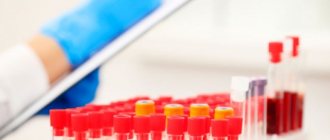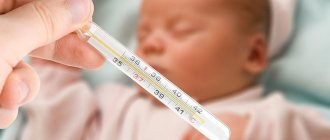Home > Encyclopedia of Oncology > What the tumor marker Ca 15-3 shows: decoding
Both when breast cancer is diagnosed and when this pathology is suspected, identifying the stage of the malignant process and determining the extent of the lesion play a huge role. One of the methods for obtaining reliable information about the patient’s condition is to analyze the mucin-type glycoprotein produced by the tumor. Women who are prescribed this study should know what the Ca 15-3 tumor marker shows in order to:
- realize the advisability of completing the procedure as soon as possible;
- dispel the misconception that elevated readings always indicate the presence of cancer;
- learn the specifics of interpretation and the importance of visiting a high-quality medical center;
- take measures to treat the detected disease without delay.
As with other blood tests, in order for the results and interpretation of the Ca 15-3 tumor marker to be accurate and reliable, the correct sequence of testing, modern equipment and proper preparation of the patient are needed. Israeli doctors, who have achieved enormous success in detecting mutated cells, can make a diagnosis at a very early stage. Thanks to an integrated approach, including laboratory and instrumental examinations, specialists assess the condition of the female body and prescribe appropriate therapy.
Characteristics of the antigen
Exceeding the norm of antigen content is characteristic of breast carcinomas. At the same time, it does not belong to the category of strictly specific, since in the first and second stages it is found in too large quantities in 1/5 of the subjects. The value of analysis as a diagnostic method is associated with its combination with CEA. If Ca 15-3 is elevated simultaneously with an increase in the norm of the tumor marker CEA, this means that the primary site of metastasis.
Interesting! The antigen is a protein compound weighing about 300 thousand Daltons and is characterized by a carbohydrate base, formed from epithelial cells of the mammary ducts.
When deciphered, the pathogenic protein content may be higher than normal not only in a patient with an advanced form of cancer, but also in healthy people or those whose cell mutation is at the initial stage.
In this regard, before making any diagnosis or prescribing therapy, especially surgical intervention or chemical treatment, women undergo additional research. In addition to ultrasound therapy, MRI and computed tomography, laboratory tests may also be required, for example, for the EMA marker. Consult an Israeli specialist
Who is the analysis indicated for?
First of all, determination of the antigen level is necessary if breast cancer is suspected or an oncological diagnosis has already been made. Decoding the Ca 15-3 tumor marker is needed not only to confirm breast pathology in women, but also to clearly understand how badly the body is affected. Treatment tactics and, accordingly, survival prognosis depend on this. Israeli clinics, such as Assuta, have innovative equipment and qualified staff, which eliminates errors when performing tests.
Important! Many patients from post-Soviet countries with carcinoma are examined in Israel, after which it turns out that the diagnosis was made incorrectly in their homeland.
Thanks to the results, the doctor can understand whether it is worth talking about cancer or hormonal mastopathy. Also, blood sampling from a vein is necessary at the stage of completing a treatment and rehabilitation course for:
- detection of metastatic formations at the initial stage;
- tracking how effective the treatment plan is. In approximately 2/3 of patients, after the start of treatment, a significant decrease in antigen levels is observed, and the preservation of indicators indicates either the progression of the disease or active metastasis;
- timely adjustment of treatment in the absence of positive dynamics of indicators - if the norm of the tumor marker Ca 15-3 is still exceeded after surgery or chemotherapy, additional monitoring and changes in the tactics of influencing cancer cells may be prescribed;
- making an objective forecast.
Tumor marker CA 15-3
Breast cancer in women is the most common malignant disease. Every eighth woman runs the risk of having this pathology. This risk especially increases after 40 years.
It is important to consider that survival rate directly depends on the stage at which breast cancer was detected. Timely diagnosed pathology can be successfully treated, while at stages III-IV the survival rate can be less than 10%.
One of the methods for early diagnosis of breast cancer is analysis of the tumor marker CA 15-3.
What is this substance?
Tumor markers are waste products, membrane particles, enzymes or other substances produced by cancer cells. They are called tumor antigens. Using them, the human immune system detects mutated cells and promptly destroys them, preventing them from multiplying into a tumor. Therefore, even in healthy people, tumor markers are always present in the blood - after all, cells mutate regularly, forcing the immune system to constantly work.
But if the level of antigens suddenly increases, this may indicate a malfunction of the immune system, an increase in cancer cells, or the development of a tumor. Each organ and each tissue has its own markers. They are called specific. Tumor marker CA 15-3 is the main indicator of breast cancer.
There are also nonspecific antigens that can be used to determine the malignancy of the process, but it is not possible to understand where exactly it is localized.
Reliability of the analysis
The CA 15-3 tumor marker test in women is only one of the methods for early diagnosis of cancer. Its reliability does not exceed 80%. Moreover, only 20% of women with stage I-II breast cancer have levels of this substance that rise above normal. Therefore, if cancer is suspected, the patient must undergo a comprehensive diagnosis, which includes mammography, elastography, MRI, biopsy and other methods.
If you have taken the test and received a suspicious result, do not panic. The level of CA 15-3 can increase due to other, non-cancerous diseases:
• Fibroadenoma of the mammary gland; • Ovarian cysts; • Endometriosis; • Hepatitis, liver cirrhosis; • Autoimmune diseases.
Pregnancy and breastfeeding often provoke an increase in the level of CA 15-3. This marker can also increase in cancer of the liver, stomach, lung or pleural tissue, ovaries, cervix and other organs.
Purposes of the tumor marker test CA 15-3 Breast antigen is always tested when breast cancer is suspected. It can be a good auxiliary factor for clarifying the diagnosis. But given its low reliability in the early stages, the test for CA 15-3 is more used for other purposes: • Differential diagnosis; • Monitoring the effectiveness of antitumor treatment; • Timely detection of metastases and relapses; • Assessing the aggressiveness of the process and the prognosis for the patient. When should you donate blood for this antigen?
There is a list of symptoms for which it is advisable for a woman to see a mammologist. He will prescribe a set of studies, one of which may be a blood test for the tumor marker CA 15-3:
• Detection of compactions in breast tissue; • Pain and feeling of heaviness in the chest; • Uncharacteristic discharge from the nipples; • Change in the shape of the nipples and halos (bulging, hollowing); • The appearance of cracks, crusts, peeling on the skin of the nipples or the entire breast; • Immobility of the mammary gland relative to the chest; • Inflammation of regional lymph nodes.
With regular visits to a mammologist and independent palpation (palpation) of the breast, in the absence of suspicious symptoms, young women have nothing to worry about. After turning 40, it is advisable to take a blood test for the tumor marker CA 15-3 to determine its initial level, and then do this test every 2-3 years.
But there are several categories of women for whom it is advisable to undergo this examination more often:
• Presence of relatives with oncology (of any organs) in the family history; • Long-term use of oral contraceptives or other hormonal drugs; • Chronically high levels of estrogen in the blood; • Regular menstrual irregularities; • Early onset of first menstruation (up to 12 years); • Late onset of menopause (after 55-60 years); • Already diagnosed cancer of any other organs.
When the diagnosis of breast cancer is confirmed, after treatment or surgery, a CA 15-3 test is performed every 3 months for the first year, every 6 months for the second year, and then once a year for the timely detection of metastases and relapses.
Tumor marker CA 15-3 - interpretation of results
Only a doctor should interpret the results of laboratory tests. You should not look for CA 15-3 norms on the Internet and draw your own conclusions based on them. There are many different standards in the world, the norms of which can vary greatly depending on the research technology. Thus, according to European standards, the normal level of CA 15-3 is less than 30 U/ml. At the same time, Helix technology says that the norm is up to 20 U/ml. A marker level above 40 U/ml is already a reason to suspect cancer and undergo additional examination.
Reagents and equipment may differ in different laboratories. Therefore, repeated tests and monitoring of fluctuations in the amount of this antigen must be carried out in the same laboratory. Remember that if the tumor marker CA 15-3 is elevated, this is not yet a diagnosis. Only after a complete diagnosis, biopsy with histological examination can a final diagnosis be made.
Preparing to donate blood
The reliability of the CA 15-3 analysis is influenced by many external and internal factors. To reduce their impact, you need to properly prepare for blood donation:
• Blood is taken from a vein, after a 10-12-hour fast, in the morning; • You need to have a light dinner, without unnecessary spices; • One day before donating blood, you need to avoid alcohol; • On the day of the analysis you should not smoke; • A few days before donating blood, you need to stop taking medications. This can only be done under the supervision of a doctor; • If medications cannot be stopped for health reasons, you must report their use. The doctor will take this information into account when interpreting the results; • On the eve of your visit to the clinic, you should not visit gyms, solariums, saunas; • On the day of the test, try not to be nervous and avoid stress.
Where is the best place to donate blood?
Breast tumor marker testing can be done in municipal clinics, private laboratories and specialized private clinics.
In the first option, the test will be free if you contact the doctor. But public medical institutions often suffer from low reliability of results, long queues for several months in advance, and unfriendly, tired staff.
Private laboratories use high-precision equipment and high-quality reagents, produce accurate results, but do not provide consultations or interpretation.
In our clinic, everything you need for diagnosis and treatment is in one place. You will be able to donate blood without queues, in a comfortable, cozy environment, undergo a comprehensive examination and receive professional psychological support.
Reasons for the increase in indicators
Although this marker is considered decisive for breast tumors, its results are not an unambiguous guarantee that there is a focus of epithelial cell mutation in the body. Among the cancers in which the tumor marker Ca 15-3 is elevated, it is worth noting:
- bronchogenic type carcinoma;
- malignant neoplasms of the cervix;
- breast cancer with metastases;
- hepatocellular tumors;
- ovarian damage;
- pancreatic oncology.
Non-oncological causes of abnormally high values may be:
- benign tumors;
- third trimester of pregnancy;
- hepatitis in chronic or acute stage;
- diseases of the endocrine system of an autoimmune nature;
- cirrhosis of the liver;
- endometriosis.
To understand what exactly a woman is sick with, you need an integrated approach to diagnosis, so it is advisable to use the services of a clinic that has not only its own laboratory, but also machines for MRI, CT and ultrasound.
Indications for analysis
The CA 15-3 cancer antigen test is considered auxiliary among specialists and is prescribed for the following purposes:
- confirmation or refutation of a malignant process in the mammary glands;
- differential diagnosis of benign and malignant tumors, mastopathy, other inflammatory or infectious processes of the mammary glands and internal organs;
- dynamic assessment of the effectiveness of surgical or conservative treatment of confirmed breast cancer;
- assessment of the likelihood of metastasis and relapse;
- making a prognosis for the course of the disease, remission, monitoring the rehabilitation of patients;
- obtaining data regarding the shape and volume of the tumor, its location and extent of spread (the greater the specific gravity of CA 15-3 in the plasma, the greater the volume of malignant cells produced by mammary tissue).
The need to prescribe this test as part of a comprehensive examination of the mammary glands may be indicated by the following clinical signs:
- the appearance of lumps, lumps or other formations in the breast tissue, which is determined visually or during palpation;
- pain in the chest, feeling of fullness or heaviness;
- pathological discharge from the nipples (including in males);
- change in the shape of the nipple (retraction, hardening, redness), the appearance of cracks or wounds on it that may bleed;
- changes in the structure of tissues and skin (redness, generalized swelling, roughness, “lemon peel” effect);
- immobility of the mammary gland (the tumor has grown into the sternum, which leads to deformation of muscle tissue and glands);
- inflammation of regional lymph nodes, their enlargement.
You can read more about breast self-examination techniques for women in our separate article.
The study is also prescribed to patients at risk for oncology:
- the presence of direct relatives who have a history of being diagnosed with cancer of internal organs;
- age over 40-50 years;
- long-term hormonal support, oral contraceptives, hormone replacement therapy;
- chronically elevated levels of estrogen in the blood;
- chronic menstrual irregularities, secondary amenorrhea;
- earlier onset of menstruation;
- late menopause;
- history of ovarian cancer.
Interpretation of the test results for cancer antigen CA 15-3 is carried out by an oncologist, mammologist, surgeon or functional diagnostician.
Pregnancy test
There are a number of differences in what the tumor marker Ca 15-3 means in pregnant women. It is performed very carefully so as not to miss the pathogenic process at the initial stage of development. The assessment of quantitative values is identical to that used when interpreting non-pregnant women:
- the norm is considered to be a protein content in the blood of up to 20-25 units per milliliter;
- indicators of 30 U/ml are threshold;
- if a concentration of more than 30 Units per milliliter is detected;
- if the readings are above 50 U/ml, then we are most likely talking about oncology.
Interesting! In completely healthy women, the norm of the tumor marker Ca 15-3 ranges from 6.5 to 13.4 units per milliliter. But sometimes, even with normal values, the likelihood of cancer exists.
When examined in the last three months of gestation, the permissible values may be exceeded, therefore, in order to clarify the diagnosis, a number of other tests and procedures are done. In the absence of symptoms and normal results, medical observation and re-diagnosis after the birth of the child are indicated.
Dynamic observation
A single acquisition of information about the antigen content does not allow one to fully assess the likelihood of cancer or determine how a malignant neoplasm is being reduced. Therefore, most often the study of the ratio of results to the norm of the tumor marker Ca 15-3 is shown in dynamics. Similar tactics are used as part of systematic observation, in particular, when a woman is diagnosed with a benign tumor and the indicators are within the acceptable limit:
- During the first year, the biomaterial is examined monthly.
- For the second year, samples are taken every 2 months.
- Third year – once a quarter.
Such tracking makes it possible to understand at what point cells will begin to mutate and there is a risk of developing breast cancer.
General information
Tumor marker CA 15-3 is an important diagnostic indicator for determining breast cancer in women and men. The relevance of the study is quite high, since over the past decades the incidence of the disease has increased by almost a third.
Analysis for CA 15-3 should be carried out over time. This approach allows us to obtain the most complete clinical picture of the course of the disease, stage, form and likelihood of cancer metastasis. The undoubted advantage of this study is that an increase in the concentration of the tumor marker CA 15-3 in the blood can precede the primary symptoms of the disease by 6-9 months. And this makes it possible for early and timely diagnosis of the oncological process.
CA 15-3 is a glycoprotein that is produced by mammary tissue. It can also be contained in the epithelium of the respiratory organs and uterus. When malignant cells appear, the level of tumor marker in the blood begins to increase. An increase in CA 15-3 values is recorded in 10% of patients with primary oncology and in 70% of patients with metastases (secondary process). That is, the tumor marker is not sensitive and indicative enough for early diagnosis of cancer if its symptoms have already appeared. But it is advisable to conduct the study to assess changes in indicators over time, to monitor the response to treatment for breast cancer and relapse of the disease.
The CA 15-3 test has the highest specificity for breast carcinoma - up to 95%. In some cases, an increase in the component in the blood can be observed in other malignant processes (for example, oncology of the gastrointestinal tract), as well as in diseases of a non-cancerous nature (fibroadenoma, inflammation of the bile ducts).
Tumor marker CA 15-3 can normally be elevated in pregnant women (up to 40 IU/l), which is due to physiological changes in the woman’s body (rapid proliferation of mammary gland tissue). Excess estrogen, which is observed in expectant mothers, creates favorable conditions for the appearance of benign and malignant cells. During lactation, hormone levels decrease, which reduces the likelihood of breast cancer.
In men, breast cancer is quite rare, and the cause is usually serious hormonal disorders during puberty and/or male menopause.
The CA 15-3 test allows you to determine the type and stage of cancer, its exact location, and also monitor the dynamics of remission after effective treatment. However, the oncologist has the right to make a final diagnosis only after conducting additional studies: tissue cytology and a blood test for cancer embryonic antigen (CEA).
CA 15-3 was elevated in all patients with proven distant metastases and in 35.5% of patients with metastases to regional lymph nodes.
What to do if the indicator is elevated
There are quite a lot of women who have high antigen levels and lumps in their breasts, and all of them are interested in correctly diagnosing their illness and maintaining health. To do this, first of all, you should undergo a comprehensive examination, and, according to reviews on the forums, for girls who have an elevated tumor marker 15-3, it is best to do this in Israel. Here they can count on the professionalism of doctors and the absence of violations of the testing and sample storage procedures. The list of necessary studies includes a biopsy (in the absence of contraindications) and mammography.
If the tumor is not malignant, then you need to undergo regular examinations by an oncologist and mammologist in the future. Then the moment of degeneration of a neoplasm into a malignant one will not be missed. Even with borderline values, one should not forget about visiting specialists, especially if there is an unfavorable family history and other factors contributing to the development of cancer, namely:
- the onset of menopause;
- previously had cancer (it does not matter which organ, although those who have recovered from breast cancer are at greater risk);
- infertility or late birth of the first child;
- early onset of menstruation.







